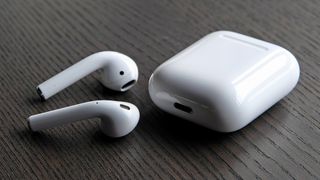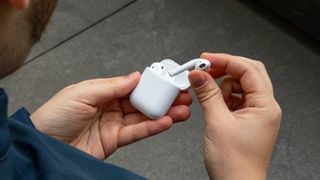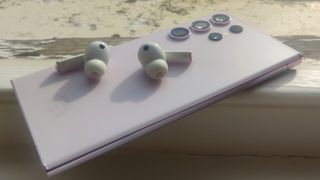It didn’t really occur to me until now, but Apple has been selling AirPods with the same design as the original launch, back in December 2016, continuously for the eight years since then.
When AirPods 2nd Gen came out, they upgraded the internals and sound, as well as added new features, but they kept essentially the same exact design for the buds and case.
It’s only now, with the arrival of AirPods 4, that this design is finally heading off for a well-earned retirement, having massively influenced and kickstarted the world of the best true wireless earbuds.
I never got on with this design at all, so I’m not exactly sorry to see it go – but it does feel like the end of an era, and I have to acknowledge that some of the best earbuds on the planet, including the ones I actually do use every day, owe a design debt to them.
AirPods were not the first Bluetooth true wireless earbuds by any means. The Bragi Dash and Earin earbuds basically fight for that honor around 2015 (it appears Bragi announced first, but Earin released first, so take your pick for the winner). I should also mention the Sennheiser MX W1 as an early pioneer in this area from back in 2008 (but those used a custom transmitter, and each earbud was the size of a gerbil).
Throughout 2016, it was clear to those around the tech world that true wireless earbuds could be a big deal. Good ol’ Apple rival Samsung had beat AirPods to the punch, releasing the Samsung Gear Icon X several months before AirPods arrived.
But none of these early earbuds really mattered to the public at large. Bluetooth’s standard hadn’t been updated for this kind of dual transmission, so companies were using fudges to make it work. (One technique, for example, used hearing-aid transmission tech to beam from one earbud to the other, which was latency-free but was prone to interference.) Connection reliability and battery life were poor, and people weren’t into the rounded bud design that was common with the early models.
AirPods were both a step forward and a step backward compared to them, and in both cases, that was an advantage.

The step forward was that they offered rock-solid connectivity compared to the competition, practical battery life, and Apple’s use of its ecosystem to avoid any hassle around pairing. They were as easy to use as Apple’s famous EarPods (introduced in 2012), but without the cable tangle.
And speaking of EarPods, perhaps Apple’s masterstroke was using nearly the same design for the AirPods as its wired earbuds. Other companies were designing something that looked new, which can be intimidating and concerning to people. How can you be sure they’ll be comfortable? Or that they’ll stay in reliably? It would be a gamble to buy them as an early adopter.
So, Apple took a step backward compared to those earbuds. It made them look like older tech – like the earbuds people already owned, but with the cable cut off. You could infer how well they would fit if you’d already tried its earbuds, so no gambling was required. It enabled Apple to create a long, thin case for them that had a familiar vibe – with their white stick-like design, it was like sliding a cigarette out from a packet. You could be the audio equivalent to James Dean pulling out a smoke and slouching against a wall.

As I mentioned above, I didn’t actually like using this design. It rubbed my ears pretty quickly and became uncomfortable. At the time, I also felt that the stick design looked silly – it was only in retrospect that I saw how smart it was. I wanted something with the cool, new, rounded designs we saw elsewhere; my first true wireless earbuds were the Bang & Olufsen E8, released in 2017.
But AirPods delivered a massive boost to the whole world of true wireless earbuds. They became the best-selling model of headphones in the world, and their visibility normalized the idea of going true wireless. The standardized technology available to other earbuds evolved rapidly in order to beat what AirPods could do and turn wireless earbuds into the dominant form of headphones. We got competition from the likes of Samsung and Sony, but also from hi-fi specialists such as Master & Dynamic and Bowers & Wilkins who simply couldn’t be left behind.
And the stick design… uh, stuck around. AirPods Pro were a great improvement on the design, and a huge number of competitors took inspiration. Even in 2024, we’ve just had Samsung actually adopt the stick design in its Pro buds for the first time in the Samsung Buds 3 Pro, and it’s being used in the fantastic Nothing Ear (a), among loads of other buds.

The oddest thing about this original AirPods design is how popular it remained right up until the end, considering how far other earbuds have surpassed the AirPods 2nd Gen for value and comfort. The best cheap earbuds provide way better sound, more features, better battery life and a more comfortable fit than AirPods 2nd Gen did, for a lower price – the Nothing Ear (a) being the prime example of that.
And yet, every time we covered a sale event on TechRadar where AirPods dropped under $90, we’d discover that they were usually the most popular product we’d feature or in the top three at the least. We’d give specific examples of other earbuds we think are a better buy, but AirPods would remain the hot thing.
Maybe it’s that safety and reliability I talked about before. Eight years is an incredibly long time for one design to stick around in the tech world, but you knew exactly what you were getting with them, and people at large liked them. Sure, I won’t miss the design, but there’s no doubt we’re saying goodbye to a true modern tech icon.
Services Marketplace – Listings, Bookings & Reviews
